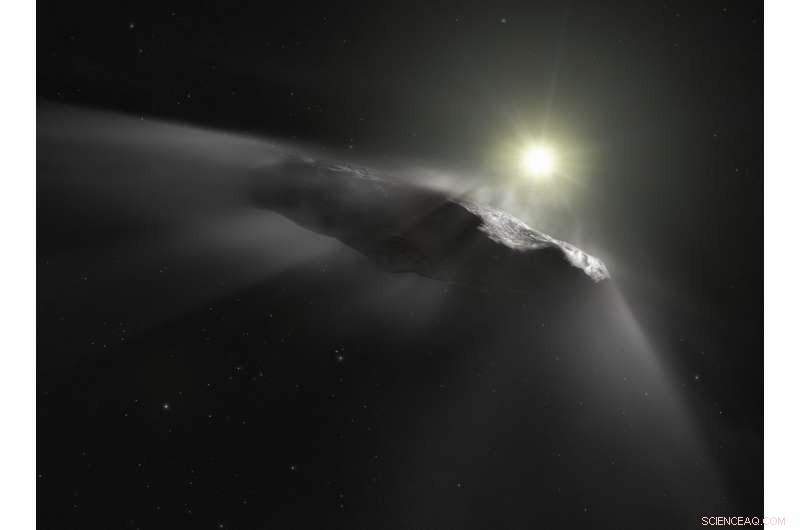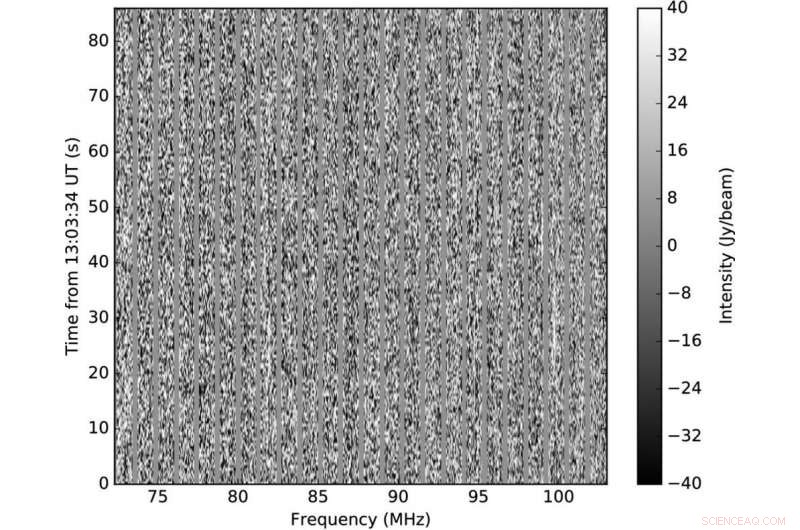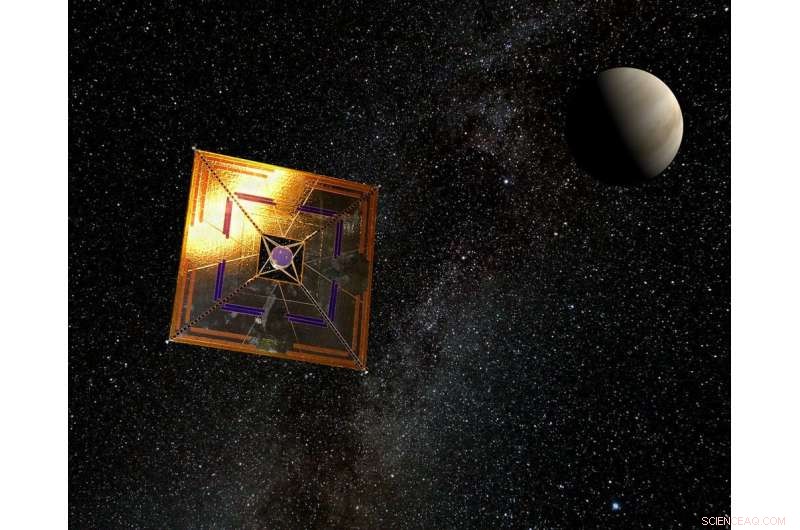
A impressão de um artista de 'Oumuamua, o primeiro objeto interestelar descoberto no sistema solar. ESA / Hubble, NASA, ESO, M. Kornmesser, CC BY
Como astrofísico, provavelmente a pergunta mais comum que me fazem é:"Estamos sozinhos no universo e existem alienígenas?"
Não há dúvida:as pessoas adoram pensar e falar sobre alienígenas. Portanto, histórias sobre a busca por inteligência extraterrestre são coletadas e relatadas com entusiasmo na mídia.
Mas o que realmente está no cerne deste tópico complicado e popular são as evidências - a natureza de qualquer evidência de vida alienígena, como vemos e respeitamos essa evidência, e como isso é comunicado ao público.
Em nenhum lugar isso é mais importante do que na cobertura de estudos científicos de um objeto misterioso - 'Oumuamua - que foi recentemente descoberto passando por nosso sistema solar. Por exemplo, duas publicações em duas revistas respeitadas revisadas por pares geraram reações muito diferentes.
Olá 'Oumuamua
'Oumuamua, significando batedor ou mensageiro em havaiano, é o nome dado ao primeiro objeto interestelar detectado a visitar nosso sistema solar. Na descoberta do ano passado, 'Oumuamua foi classificado como um cometa, mas isso foi posteriormente retirado quando nenhuma evidência de atividade cometária foi detectada.
'Oumuamua foi rapidamente descoberto como tendo uma órbita que não pertence ao nosso sistema solar. Tem uma origem em outra parte da nossa galáxia, e uma trajetória que o viu atravessar o sistema solar interno ao longo de alguns meses.
Passou perto do Sol e da Terra, e descobriu-se que tinha uma geometria incomum, cerca de 200 metros de comprimento e cerca de 35 metros de largura, girando a cada sete horas.
A descoberta de 'Oumuamua gerou muita atenção na comunidade científica, e na mídia. Dada sua geometria incomum e sua origem fora do sistema solar, logo foram feitas perguntas sobre se 'Oumuamua poderia ser uma espaçonave.
As observações foram feitas com radiotelescópios para procurar qualquer evidência direta de transmissões indicando vida inteligente, incluindo por uma equipe liderada por mim usando um telescópio australiano (o Murchison Widefield Array). Ouvimos frequências de rádio FM, na base de que qualquer vida inteligente em 'Oumuamua pode reconhecer frequências FM populares na Terra.
Nenhuma evidência direta de vida inteligente foi jamais encontrada nessas buscas.
Mais dados concretos sobre 'Oumuamua
Observações extensas e impressionantes com uma gama de telescópios, incluindo o telescópio espacial Hubble, foram feitos para determinar com precisão a trajetória de 'Oumuamua. Resultados do estudo, por uma equipe de astrônomos liderada por Marco Micheli da Agência Espacial Europeia, foram publicados na Nature em junho.
Essas observações muito cuidadosas mostraram que 'Oumuamua acelerou ao deixar o sistema solar, revelando a existência de "forças não gravitacionais". Isso significa que a trajetória do objeto não poderia ser explicada apenas pela gravidade do sol e de outros objetos importantes em nosso sistema solar.
Existem várias explicações possíveis para a aceleração. Uma é que o gás aquecido escapando de 'Oumuamua (liberação de gás) poderia produzir uma força que causou a aceleração observada. Isso é comumente visto em cometas normais.
Mas 'Oumuamua ainda não mostra nenhuma evidência de atividade cometária. A equipe de Micheli analisou seis explicações possíveis e concluiu que a liberação de gases é a opção mais provável, mesmo que não haja nenhuma evidência direta de que seja esse o caso.
Eles mostraram que a aceleração de 'Oumuamua é incomum, mas dentro dos limites do que foi visto anteriormente para cometas do sistema solar.
Uma das explicações descartadas pela equipe de estudo é que 'Oumuamua foi acelerado pela pressão da radiação do nosso sol. A radiação do sol pode empurrar os objetos para longe dele.
Mas eles concluíram que esta explicação não é preferida, porque significa que a densidade de 'Oumuamua teria que ser muito baixa. Um objeto precisa ter uma grande área de superfície e baixa massa (baixa densidade) para ser acelerado pela pressão de radiação.
Podem ser alienígenas?
Another study by postdoctoral researcher Shmuel Bialy and distinguished astronomer Avi Loeb, from Harvard University, took a different approach.
Details of the study have just been published in November's The Cartas de jornal astrofísico , but were available online earlier.
The authors chose to presumir solar radiation pressure to be the cause of the acceleration, and then determined the properties of 'Oumuamua required to make this work. They require an object with thickness less than 1mm, an areal mass density of 1 to 2 grams per square centimetre, and a large area.

Data from the Murchison Widefield Array, showing no detection of radio signals from ‘Oumuamua in the frequency range 70-105MHz (containing the FM band). Credit:Steven Tingay and co-authors, Autor fornecido
It is unlikely that nature would produce such an extreme geometry. The authors quickly mention this, before moving to a discussion that, under the assumption that solar radiation is the cause for the acceleration, 'Oumuamua is artificial—that means the product of an alien civilisation.
The properties the authors derive under their assumptions are similar to those of solar sails being designed and built by humans as a possible way to travel interstellar distances.
Bialy and Loeb spend half of their article discussion section on the idea that 'Oumuamua could be a defunct or active solar sail belonging to an alien civilisation.
The nature and communication of evidence
Bialy and Loeb did not issue a press release about their study, but the media picked up the paper once it was accepted and available online, prior to this week's journal publication.
(This is something that happened to me in 2012, leading to my published non-detection of aliens being run on the front page of the BBC news website.)
Bialy and Loeb's publication attracted headlines such as this, for example:"Harvard astronomers claim Oumuamua is ALIEN PROBE - 'Nothing like we've ever seen!'". Most other reporting was more balanced.
This is pretty normal. A lot of the media jump to aliens in the reporting of space and astronomy, even when the original reported studies have never mentioned aliens. Recent reporting of Fast Radio Bursts (FRBs) is an example.
What surprised me was the reaction of some of my colleagues to Bialy and Loeb's paper. Nas redes sociais, there have been some pretty personal attacks by scientists – on Loeb in particular – for being in the media for this work.
Both new studies lay out their assumptions, cite substantial evidence, and undertake rigorous calculations. Both were accepted by top-quality journals after independent peer review.
Both finish with bottom lines that the studies of 'Oumuamua are inconclusive and we will need to examine more such objects that come through the solar system in the future.
Both sets of authors also come up with different perspectives and motivate different questions. But Loeb has ended up in the media, talking about his paper, and is being panned by some colleagues for it.

Artist’s impression of the IKAROS mission using a solar sail. Credit:Wikimedia/Andrzej Mirecki, CC BY-SA
Since the pre-journal paper was picked up he told me he has been swamped by media interest. "I use the discussions with the media as a platform for highlighting the standard scientific methodology:an anomaly is observed in data, the standard explanation fails to explain it, and so an alternative interpretation is proposed. I encourage anyone with a better explanation to write a paper about it and publish it. Wrong interpretations can be ruled out when more data will be released on 'Oumuamua or other members of its population in the future."
As for the negative reactions he has received, he referred to an article he recently published where he paraphrased another scientist known for his once-controversial theories. "As Galileo reasoned after looking through his telescope, 'in the sciences, the authority of a thousand is not worth as much as the humble reasoning of a single individual.'"
Let's talk about evidence
Given my work on observations of 'Oumuamua, a few journalists have contacted me for comment.
These have been great opportunities to discuss in depth with journalists the nature of evidence, the difference between something being consistent with observations and direct evidence for a conclusion, and the need for evidence to be commensurate with the impact of a claim.
If aliens are claimed, direct and robust evidence is required – not a conclusion based on a few observations that are difficult to explain, plus a bunch of assumptions.
But no scientist has claimed 'Oumuamua is alien in this discussion – they have just raised questions and explored answers.
There is no point in shying away from a proper discussion on the search for extraterrestrial intelligence, or in being personally critical of colleagues.
Scientists should take every opportunity to engage with the public and the media on the topic, given the public's interest and the media's willingness to report.
It is interesting, Diversão, and scientific, and a great opportunity to discuss the scientific method and science in an engaging manner. The media reporting of 'Oumuamua shows that (aside from a few headlines), the content of reports is generally pretty good and responsible.
Whatever 'Oumuamua is (almost certainly not made by aliens, in my view), it is a fascinating object and presents lots of interesting scientific questions that will trigger further studies and observations.
We will never see 'Oumuamua again, and we may never know exactly what it is. But seeing 'Oumuamua in the news is likely to inspire some kids to take up a career in science.
Este artigo foi republicado de The Conversation sob uma licença Creative Commons. Leia o artigo original. 